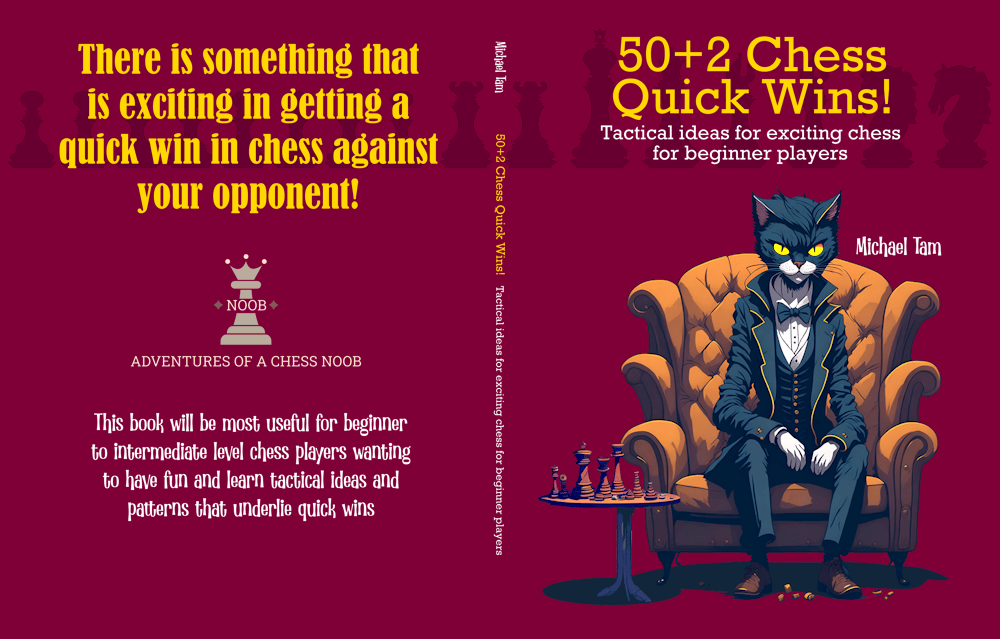
Brilliant Bishop Sacs | Bxf7+!! vs the Scandinavian! ⚡ Quick Wins #107
#scandinavian #bishopsac #brilliant #quickwins

![]()
It’s been a really busy week for me both at work, but also with reviews for my chess channel and blog! Last week, I published my review on the amazing robotic chess board, the Chessnut Move, and later this week, I’ll be reviewing a very luxurious set of chess pieces, the 1849 Staunton set (reproduction of the OG design by Englishman Nathaniel Cooke, produced by Jacques of London, and named after and promoted by Howard Staunton himself), sent to me by Royal Chess Mall.
![]()
* * *
![]()
However, between these reviews, I really wanted to showcase some quick wins! I had these two games quite close together and they demonstrate a common theme; the use of a brilliant bishop sacrifice (Bxf7+!!) against the Scandinavian Defense. Let’s go!
![]()
Leonhard Gambit, Queen Trap!
The first game I had in a game of 5+5 blitz, and it’s a line straight out of my book, “Become a Chess Assassin”, the chapter titled “Leonhardt Gambit, Queen Trap”. It starts with what is now considered the Main Line of the Scandinavian Defense (1. e4 d5 2. exd5 Qxd5 3. Nc3 Qa5), and White’s unexpected and surprisingly good Romantic attack (4. b4). From the opening to the chapter:
The Scandinavian Defense was known to all the chess masters of the Romantic era, though it was not very popular. Joseph the Black Death Blackburne and Jacques Mieses (1865-1954) were exceptions and developed the modern theory of the opening. The name, Scandinavian Defense, was adopted by Ludvig Collijn (1878-1939) who played the opening extensively, including at the first Nordic Chess Championship in 1897. He later became the inaugural Chair of the Swedish Chess Federation. This name eventually caught on as the opening became more popular in the modern era. Up until the mid-to-late-twentieth century, it was better known by the descriptive name, the Center Counter Defense/Game.
As for the namesake of the gambit, Paul Saladin Leonhardt (1877-1934) was a German chess player and journalist. Born in Poznań, then part of Prussia in the German Empire, and now part of modern Poland, Leonhardt became a lifelong chess enthusiast while studying in Leipzig. And lifelong is no exaggeration as he literally died from a heart attack, while playing chess at the Königsberg chess club! Leonhardt was not well known in his time, as he did not play in many tournaments. However, he was a very strong player and has been recorded to have defeated some of the strongest players of the era, including Tarrasch, Tartakower, Nimzowitsch, Maróczy, Schlechter, and Réti.
The gambit itself is named from Leonhardt’s surprising (4. b4) in a game against Mieses (Leonhardt—Mieses, 1908), one of the Scandinavian Defense experts. After (4… Qxb4), Leonhardt enters the gambit Main Line with the second surprise of (5. Rb1)! Curiously, and likely unknown to Leonhardt, our protagonist from the previous chapter, Emanuel Lasker, used the line a few years earlier in a simul exhibition during a US tour (Lasker—Berg, 1905)!
— Leonhardt Gambit, Queen Trap. In: Become a Chess Assassin! (2024), p. 214
![]()
In the trap, we don’t play the main line of the Leonhard Gambit (5. Rb1), but commit to a scandalously winning multi-step trap, that has no business being as effective as it is at the beginner-intermediate level! The trap works through misdirection. Each move has a surface level logic that obscures the true purpose.
It starts with (5. Nb5!?). Superficially? White is attacking the c7-pawn which would come with an absolute check of Black’s king and a8-rook. Black’s natural (and most accurate) move is returning the queen to her previous square (5… Qa5) and defending the c7-pawn. However, our true purpose is to bring Black’s queen back onto the fifth rank, and to position the knight for a devastating discovered attack in a few turns!
The second step is (6. Bc4!?). Superficially, it just looks like a typical developing move for the bishop. However, the true purpose is the forcing bishop sacrifice! Black must find the correct move to foil the trap, but most do not. The correct move is (6… Nf6) to defend the h5 square. Instead, Black will commonly kick White’s b5-knight with either a6 or c6; and (6… c6??) was played in this game, a blunder!
White now strikes with a beautiful bishop sac, the theme of this article (7. Bxf7+!!). Black is already losing but has one final chance to avoid devastation by refusing to take the bishop and playing (7… Kd8). Most will take the bishop (7… Kxf7??) and White has an overwhelming win likelihood advantage! In the Lichess community database, White wins 81% of the time vs Black 18%!
Having drawn Black’s king onto f7, White’s queen strikes with (8. Qh5+!), another check! Every legal move for Black in the position is dead lost, and I cover all three variations (g3, Kf6, Ke6) in my book chapter. In this game, Black played the most accurate and common response (8… g6), and the final step of the trap is revealed with (9. Nd6+!). White sacrifices their knight with check and reveals that the queens gaze at each other unimpeded across the board on the fifth rank! Black must respond to the check and so has nothing better than (9… exd6) and lose their queen. An emotionally damaging blow, many players resign on turn 9, good game, GG!
![]()
Bxf7+!! Keep your eyes on the prize!
I don’t have any hard statistical evidence, but my experience has been that Bxf7+ is more commonly available against the Scandinavian, than other openings. Sacrificing the bishop is a common tactical motif, but it often cannot work. Simply, it takes too many steps of tempo for it to be set up. Effectively, Black should always be able to defend against this attack in the opening and do so playing ordinary opening moves.
So, what’s different about the Scandinavian Defense? 🤔 My interpretation is that Black’s excursion with their early queen manoeuvres reduces the “degrees of freedom” that they have with their subsequent moves. That is, they must play more accurately to avoid the attack on f7 as they have expended turns doing other things. And where one side must play more accurately gives a psychological advantage to the other! As we saw in the first game, Black’s natural moves in the opening resulted in them neglecting the defence of the f7 square. When playing with the white pieces, we need to keep our eye on the prize, be sensitised to this possible tactic, and strike to our advantage when opportunity appears!
In this game of 5+5 blitz, my opponent played the Modern Variation (1. e4 d5 2. exd5 Nf6). Against this, my usual approach is to give back the pawn (3. d4 Nf6), which potentially wins some tempo as Black’s knight has moved twice in the opening. The following moves are the top one or two most common moves (4. Nf3 Bg4), and when I analysed the game afterwards on OpeningTree.com, my opponent’s most common approach with Black (when allowed) was indeed the Modern Variation of the Scandinavian.
Eyes on the prize; (5. Bc4), a normal developing square for the bishop with vision of f7. Against this, Black played a relatively slower move (5… a6), which while it wasn’t a mistake per se, didn’t negate my tactic. The engine identifies that indeed, (5… e6) blocking the light square diagonal was best. I then saw a tricky move with (6. Nc3!?), encouraging Black to trade knights (moving their knight a third time in the opening), which would seemingly cause damage to my pawn structure (6… Nxc3 7. bxc3).

![]()
And it worked! Black moved in 2.2 seconds, indicating an immediate response, but (6… Nxc3??) is a blunder that opens the light square diagonal to a brilliant bishop sac (7. Bxf7+!!). The bishop goes Super Saiyan, powers up, and just smashes up the place!

![]()
An interesting thing occurs as one enters the intermediate level. Against beginners, everybody captures the bishop and soon, people learn of and can see the “unpinning tactic” that occurs. As we saw in the first game, the better move was for the king to step aside rather than accept the sacrifice. My opponent did the same in this game with (7… Kd7??). However, sometimes accepting the sacrifice is the correct move, and in this game, stepping aside was a game ending blunder!
My queen gave check (9. Qxg4+); Black blocked with their knight (9… Nd7); which was captured (10. Nxd7); traded (10… Qxd7); and Black’s queen was skewered (11. Be6); and after trading (11… Qxe6+ 12. Qxe6+ Kb8), Black’s hapless c3-knight which initiated the sequence six turns earlier, was captured as the cherry on top! Emotional damage, good game, GG!
![]()
* * *
![]()
Learn how to play the best chess opening attacks in the Romantic style, including the Leonhard Gambit, Queen Trap, with my new book, “Become a Chess Assassin!”.




